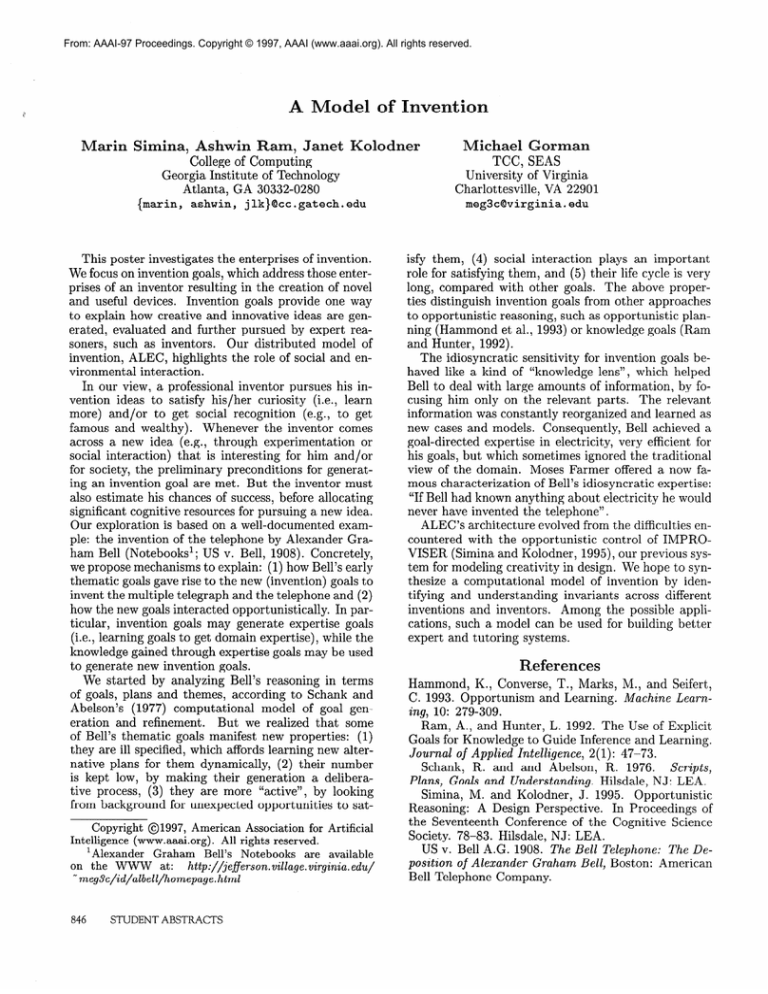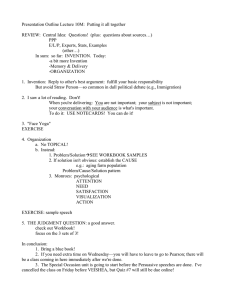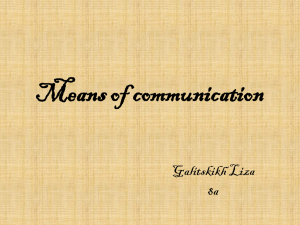
From: AAAI-97 Proceedings. Copyright © 1997, AAAI (www.aaai.org). All rights reserved.
Marin
Simina,
Ashwin
Ram,
Janet Kolodner
College of Computing
Georgia Institute of Technology
Atlanta, GA 30332-0280
marin,
ashwin, jlk}@cc.gatech.edu
{
This poster investigates the enterprises of invention.
We focus on invention goals, which address those enterprises of an inventor resulting in the creation of novel
and useful devices. Invention goals provide one way
to explain how creative and innovative ideas are generated, evaluated and further pursued by expert reasoners, such as inventors. Our distributed model of
invention, ALEC, highlights the role of social and environmental interaction.
In our view, a professional inventor pursues his invention ideas to satisfy his/her curiosity (i.e., learn
more) and/or to get social recognition (e.g., to get
famous and wealthy). Whenever the inventor comes
across a new idea (e.g., through experimentation or
social interaction) that is interesting for him and/or
for society, the preliminary preconditions for generating an invention goal are met. But the inventor must
also estimate his chances of success, before allocating
significant cognitive resources for pursuing a new idea.
Our exploration is based on a well-documented example: the invention of the telephone by Alexander Graham Bell (Notebooks ‘; US v. Bell, 1908). Concretely,
we propose mechanisms to explain: (1) how Bell’s early
thematic goals gave rise to the new (invention) goals to
invent the multiple telegraph and the telephone and (2)
how the new goals interacted opportunistically. In particular, invention goals may generate expertise goals
(i.e., learning goals to get domain expertise), while the
knowledge gained through expertise goals may be used
to generate new invention goals.
We started by analyzing Bell’s reasoning in terms
of goals, plans and themes, according to Schank and
Abelson’s (1977) computational model of goal generation and refinement. But we realized that some
of Bell’s thematic goals manifest new properties: (1)
they are ill specified, which affords learning new alternative plans for them dynamically, (2) their number
is kept low, by making their generation a deliberative process, (3) they are more “active”, by looking
from background for unexpected opportunities to satCopyright 01997, American Association for Artificial
Intelligence (www.aaai.org).
All rights reserved.
‘Alexander
Graham
Bell’s
Notebooks
are available
on the WWW
at:
http://je~erson.village.virginia.edu/
_ meg3c/id/albell/homepage.
html
846
STUDENT ABSTRACTS
Michael
Gorman
TCC, SEAS
University of Virginia
Charlottesville, VA 22901
meg3cQvirginia.edu
isfy them, (4) social interaction plays an important
role for satisfying them, and (5) their life cycle is very
long, compared with other goals. The above properties distinguish invention goals from other approaches
to opportunistic reasoning, such as opportunistic planning (Hammond et al., 1993) or knowledge goals (Ram
and Hunter, 1992).
The idiosyncratic sensitivity for invention goals behaved like a kind of “knowledge lens”, which helped
Bell to deal with large amounts of information, by focusing him only on the relevant parts. The relevant
information was constantly reorganized and learned as
new cases and models. Consequently, Bell achieved a
goal-directed expertise in electricity, very efficient for
his goals, but which sometimes ignored the traditional
view of the domain. Moses Farmer offered a now famous characterization of Bell’s idiosyncratic expertise:
“If Bell had known anything about electricity he would
never have invented the telephone”.
ALEC’s architecture evolved from the difficulties encountered with the opportunistic control of IMPROVISER (Simina and Kolodner, 1995)) our previous system for modeling creativity in design. We hope to synthesize a computational model of invention by identifying and understanding invariants across different
inventions and inventors. Among the possible applications, such a model can be used for building better
expert and tutoring systems.
References
Hammond, K., Converse, T., Marks, M., and Seifert,
C. 1993. Opportunism and Learning. Machine Learning, 10: 279-309.
Ram, A., and Hunter, L. 1992. The Use of Explicit
Goals for Knowledge to Guide Inference and Learning.
Journal of Applied Intelligence,
2(l): 47-73.
Schank, R. and and Abelson, R. 1976. Scripts,
Plans, Goals and Understanding.
Hilsdale, NJ: LEA.
Simina, M. and Kolodner, J. 1995. Opportunistic
Reasoning: A Design Perspective. In Proceedings of
the Seventeenth Conference of the Cognitive Science
Society. 78-83. Hilsdale, NJ: LEA.
US v. Bell A.G. 1908. The Bell Telephone:
The Deposition of Alexander Graham Bell, Boston: American
Bell Telephone Company.





